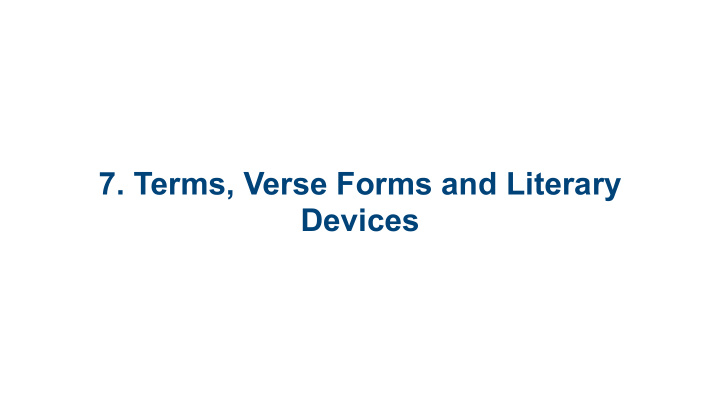



7. Terms, Verse Forms and Literary Devices
Verse and stanza: • Verse: a verse is a line in a poem • Stanza: a stanza is a group of verses, many times with some sort of meter and order.
A slant rhyme (also called half rhyme, imperfect rhyme) is when only the stressed syllables of the consonants match.
Emily Dickinson, “Hope Is the Thing with Feathers” "Hope" is the thing with feathers That perches in the soul And sings the tune without the words And never stops at all,
Free verse doesn’t follow a regular meter or rhythm. It’s the closest form to imitating conversation.
Walt Whitman, “A Noiseless, Patient Spider” A noiseless, patient spider, I mark’d, where, on a little promontory, it stood, isolated; Mark’d how, to explore the vacant, vast surrounding, It launch’d forth filament, filament, filament, out of itself; Ever unreeling them—ever tirelessly speeding them.
The sonnet is perhaps the most famous of poetry forms. • They are 14 lines, usually in iambic pentameter ( a meter in poetry consisting of an unrhymed line with five “feet” with each foot having an unaccented syllable and an accented one) .
• There are two types of main sonnets, the Petrarchan sonnet and the Shakespearean sonnet.
The Petrarchan sonnet is made up two major sections, a major group of 8 lines (the octave) and a minor group of six lines (the sestet). The rhyme scheme is usually abba abba cde cde .
The Shakespearean sonnet is a poem made up three quatrains (a verse of four lines) and a couplet (a verse of two lines). The rhyme scheme usually is abab cdcd efef gg .
The epic poem is a long narrative poem usually about the heroic deeds of a person or nation, like Homer’s The Odyssey or The Iliad .
Metaphor – a figure of speech that refers to one thing by mentioning another. “All the world’s a stage” An extended metaphor that compares two things that are not alike is called a conceit.
Simile – a comparison using “like” or “as”. “It’s cold as the arctic in here”
Allusion – a figure of speech that makes reference to an event, a place or a person. “You are Superman. That’s heavy for me.” “What an Eden that place was”
Personification – giving human characteristics to a thing or an abstraction. “The grass crept up on me. Now I have to mow it.”
Motif – A recurring subject or theme in art (literary, visual, musical)
Alliteration is the repetition of similar sounds (like we saw in consonance and assonance) “Rubber baby buggy bumpers”
Hyperbole – an exaggeration (overstatement). “I have a ton of things to do”
Onomatopoeia – the formation of words that sound like the object to which they refer. “Chickadee” “Buzz” “Cuckoo”
Oxymoron – when a seemingly self- contradictory effect is produced. “Jumbo shrimp” “Dark light”
Apostrophe - is when a writer detaches her/himself from reality and talks to an imaginary character.
Paradox – a self- contradictory statement, but one that might express a truth. "Your enemy’s friend is your enemy”
Synecdoche – when the part is taken for the whole, or vice versa. “Let’s have a glass” “Ask for her hand in marriage”
Satire is a literary mode that uses humor, ridicule and irony to expose, criticize or denounce evil, stupidity and vices of people, institutions or beliefs, usually in politics or other contemporary issues.
It uses irony, parody, hyperbole, understatement, sarcasm, wit, inversion and other literary techniques.
Irony – using opposite language to create effect WWI was the “war to end all wars”
Parody – an exaggerated imitation of a writer, artist or genre for comic outcome Don Quixote is a parody of the chivalric novels
Understatement – presenting something as smaller or less important than it is. Describing a gunshot wound as a “scratch”.
Sarcasm – mocking with irony "Where is the flood?” If someone wears pants that are too short.
A novella is longer than a short story but shorter than a novel.
In short stories and novels Who - the characters What – the plot in the novel Where – space in the novel (setting) When – time in the novel (setting) How – language and narration Why – the theme(s) of the novel
The characters in the novel are a primordial part of this literary genre. we follow the actions of the protagonist, who develops in a certain way, against the opposing forces of the antagonist.
The plot has different stages of development: • Exposition • Development • Climax • Denouement (resolution)
Narration • An example of first person narration is To Kill a Mockingbird by Harper Lee. • An example of third person narration is Joseph Heller’s Catch-22 .
Recommend
More recommend